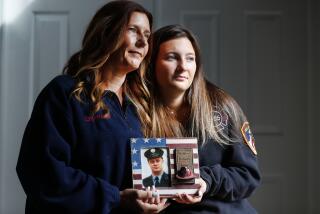9/11 Report Reveals New Details of Fight for Flight 93
WASHINGTON — In their red bandannas and with their hands at the controls as their comrades desperately tried to stave off the passengers storming the cockpit door, there came these haunting last words as United Airlines Flight 93 rolled over and smashed at 580 miles an hour into a Pennsylvania farm field:
“Allah is the greatest! Allah is the greatest!”
Of the four passenger jets hijacked the morning of Sept. 11, what occurred on the flight that left Newark, N.J., intended for San Francisco continues to both frighten and inspire the American public.
The other three jumbo jets hit their targets: the twin towers of the World Trade Center in New York and the Pentagon. But United Flight 93 was different. Here was a real life-and-death struggle, where many of the passengers already knew the other planes had been destroyed and decided to fight back against the four terrorists who had commandeered their Boeing 757.
The report issued last week by the Sept. 11 commission offered fresh details of the final reckoning of Flight 93 some 34,000 feet above rural Shanksville in western Pennsylvania.
The hijackers began checking in at Newark shortly after 7 a.m., clearing security with relative ease. By 7:48 a.m. all four had boarded and taken their first-class seats. Ziad Jarrah settled into 1B, closest to the cockpit.
Because of typically heavy morning traffic at the airport, the plane lifted off at 8:42 a.m. -- well past its planned 8 a.m. departure. The innocents aboard were two pilots, five flight attendants and 33 passengers.
“By all accounts the first 46 minutes of Flight 93’s cross-country trip proceeded routinely,” the report said. All that changed at 9:24 a.m. when the cockpit was advised by ground controllers that other planes had been stolen from the sky. “Beware any cockpit intrusion,” came the text-message warning. “Two a/c [aircraft] hit World Trade Center.”
Within two minutes, Flight 93’s pilot, Jason Dahl, responded with puzzlement: “Confirm latest msg, plz -- Jason.”
Two minutes after that, the four young men attacked. The plane was then 35,000 feet above eastern Ohio. It suddenly dropped 700 feet. Eleven seconds into the freefall a Federal Aviation Administration traffic control center in Cleveland recorded two bits of sound -- shouts, really -- from the cockpit.
“Mayday,” came the first broadcast, from Dahl or the first officer.
“Hey get out of here -- get out of here -- get out of here!” was the second.
At 9:32 a.m., Jarrah was in the pilot’s seat. He announced, “Ladies and gentlemen: Here the captain. Please sit down. Keep remaining sitting. We have a bomb on board. So, sit.”
The flight data recorder indicates that Jarrah instructed the plane’s autopilot to turn the aircraft around and head east -- presumably toward a target in Washington.
The recorder also indicates that a woman, mostly likely a flight attendant, was struggling with one of the hijackers “who killed or otherwise silenced her,” the report said.
In the main cabin, passengers were frantically dialing cellphones and the GTE phones installed on the plane.
“According to one call, they voted on whether to rush the terrorists in an attempt to retake the plane. They decided, and acted,” the report said.
At 9:57 a.m., the passenger assault began. One caller clicked off her phone with these words: “Everyone’s running up to first class. I’ve got to go. Bye.”
The commission believes two hijackers were in the cockpit with the other two stationed outside the cockpit door, guarding against any move to win back the plane. And commissioners believe that Jarrah was aware the passengers were coming for him.
He rolled the plane to the left and right, trying to knock them off balance. He pitched the nose of the plane up and down.
At 10:00:03 a.m. Jarrah stabilized the plane. Five seconds later he asked, “Is that it? Shall we finish it off?” A comrade told him, “No. Not yet. When they all come, we finish it off.”
More sounds of fighting continued outside the cockpit. Again, Jarrah pitched the nose up and down. A passenger in the background said, “In the cockpit. If we don’t we’ll die!” Another yelled, “Roll it!” -- an apparent reference to the flight attendants’ meal cart, which they used for a battering ram.
(Separately, a passenger, Todd Beamer, called his wife from the plane and she later reported hearing someone say “Let’s roll.” )
As the final assault on the cockpit began, Jarrah stopped shaking the plane. He said, “Allah is the greatest! Allah is the greatest!” He asked another hijacker in the cockpit, “Is that it? I mean, shall we put it down.” He was told, “Yes, put it in it, and pull it down.”
The passengers continued fighting for control of their fate. The time was 10:02:23 a.m.
As the plane headed down, it was jerked hard to the right. The plane rolled onto its back.
One of the hijackers began shouting, “Allah is the greatest! Allah is the greatest!”
All aboard United Airlines Flight 93 died.
They were just 20 minutes’ flying time from Washington.
More to Read
Sign up for Essential California
The most important California stories and recommendations in your inbox every morning.
You may occasionally receive promotional content from the Los Angeles Times.











